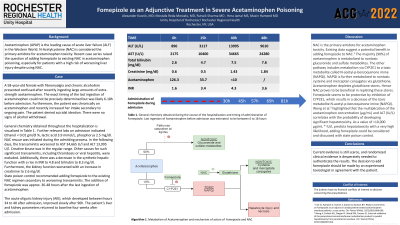Back


Poster Session A - Sunday Afternoon
Category: Liver
A0585 - Fomepizole as an Adjunctive Treatment in Severe Acetaminophen Poisoning
Sunday, October 23, 2022
5:00 PM – 7:00 PM ET
Location: Crown Ballroom

Has Audio

Alexander Kusnik, MD
Rochester Regional Health - Unity Hospital
Rochester, NY
Presenting Author(s)
Alexander Kusnik, MD1, Mostafa Reda Mostafa, MD1, Rutwik Sharma, MD1, Hera Jamal, MS2, Mazin Hameed, MD1
1Rochester Regional Health - Unity Hospital, Rochester, NY; 2Lake Erie College of Osteopathic Medicine, Rochester, NY
Introduction: Acetaminophen is the most common cause of acute liver failure (ALF) in the United States. We report a case of acetaminophen overdose treated with N-acetyl cysteine (NAC) and fomepizole.
Case Description/Methods: A 58-year-old female presented with altered mental status. Her past medical history was significant for fibromyalgia and chronic alcoholism. She had been experiencing abdominal pain over the last two days and had taken copious amounts of extra-strength acetaminophen. She was unable to specify the exact number or last ingestion of acetaminophen. Her last alcohol consumption was multiple days ago with no signs of withdrawal. Initial labs were significant for an acetaminophen level of 126.3 ug/ml, ethanol < 0.01 gm/dl %, AST of 2175U/l, ALT of 896 U/l and total bilirubin of 2.6 mg/dl, INR 1.6 (baseline of 1), lactic acid 3.9 mmol/L, phosphorus 2.5 mg/dl. NAC rescue was immediately initiated. In the following days, the transaminitis worsened to AST 34,665 U/l, and ALT 13,995 U/l. Additionally, there was an increase in INR to 4.8, bilirubin to 8.3 mg/dl, and Creatinine increased to 2.6 mg/dl (baseline 1mg/dl). Irrespective of these values, her encephalopathy improved already one day after admission. A viral and autoimmune panel remained unremarkable, imaging indicated patent veins and trace perihepatic ascites. King’s College criteria were calculated daily but did not indicate the need for transplant evaluation. State poison control recommended the addition of fomepizole to the existing NAC regimen after 48 hours secondary to worsening transaminitis. The patient’s liver and kidney function improved significantly returning to baseline 4 weeks after admission.
Discussion: NAC is known as the primary antidote for acetaminophen toxicity, but there might be a potential benefit to adding fomepizole, especially in massive acetaminophen overdoses. The proposed hepatoprotective effect is likely explained by an oversaturation of the regular glucuronidation pathway and a fomepizole-driven inhibition of CYP2E1. This results in a decrease of the toxic metabolite N-acetyl-p-benzoquinone imine (NAPQI). Wong et al. suggested in a retrospective data analysis that the multiplication of the concentration of acetaminophen (µg/mL) and ALT (IU/L) is correlating with the probability to develop significant hepatotoxicity. As a value of >10,000 µg/mL * IU/L predicts hepatotoxicity with a very high likelihood, the addition of fomepizole should be considered and discussed with state poison control.
Disclosures:
Alexander Kusnik, MD1, Mostafa Reda Mostafa, MD1, Rutwik Sharma, MD1, Hera Jamal, MS2, Mazin Hameed, MD1. A0585 - Fomepizole as an Adjunctive Treatment in Severe Acetaminophen Poisoning, ACG 2022 Annual Scientific Meeting Abstracts. Charlotte, NC: American College of Gastroenterology.
1Rochester Regional Health - Unity Hospital, Rochester, NY; 2Lake Erie College of Osteopathic Medicine, Rochester, NY
Introduction: Acetaminophen is the most common cause of acute liver failure (ALF) in the United States. We report a case of acetaminophen overdose treated with N-acetyl cysteine (NAC) and fomepizole.
Case Description/Methods: A 58-year-old female presented with altered mental status. Her past medical history was significant for fibromyalgia and chronic alcoholism. She had been experiencing abdominal pain over the last two days and had taken copious amounts of extra-strength acetaminophen. She was unable to specify the exact number or last ingestion of acetaminophen. Her last alcohol consumption was multiple days ago with no signs of withdrawal. Initial labs were significant for an acetaminophen level of 126.3 ug/ml, ethanol < 0.01 gm/dl %, AST of 2175U/l, ALT of 896 U/l and total bilirubin of 2.6 mg/dl, INR 1.6 (baseline of 1), lactic acid 3.9 mmol/L, phosphorus 2.5 mg/dl. NAC rescue was immediately initiated. In the following days, the transaminitis worsened to AST 34,665 U/l, and ALT 13,995 U/l. Additionally, there was an increase in INR to 4.8, bilirubin to 8.3 mg/dl, and Creatinine increased to 2.6 mg/dl (baseline 1mg/dl). Irrespective of these values, her encephalopathy improved already one day after admission. A viral and autoimmune panel remained unremarkable, imaging indicated patent veins and trace perihepatic ascites. King’s College criteria were calculated daily but did not indicate the need for transplant evaluation. State poison control recommended the addition of fomepizole to the existing NAC regimen after 48 hours secondary to worsening transaminitis. The patient’s liver and kidney function improved significantly returning to baseline 4 weeks after admission.
Discussion: NAC is known as the primary antidote for acetaminophen toxicity, but there might be a potential benefit to adding fomepizole, especially in massive acetaminophen overdoses. The proposed hepatoprotective effect is likely explained by an oversaturation of the regular glucuronidation pathway and a fomepizole-driven inhibition of CYP2E1. This results in a decrease of the toxic metabolite N-acetyl-p-benzoquinone imine (NAPQI). Wong et al. suggested in a retrospective data analysis that the multiplication of the concentration of acetaminophen (µg/mL) and ALT (IU/L) is correlating with the probability to develop significant hepatotoxicity. As a value of >10,000 µg/mL * IU/L predicts hepatotoxicity with a very high likelihood, the addition of fomepizole should be considered and discussed with state poison control.
Disclosures:
Alexander Kusnik indicated no relevant financial relationships.
Mostafa Reda Mostafa indicated no relevant financial relationships.
Rutwik Sharma indicated no relevant financial relationships.
Hera Jamal indicated no relevant financial relationships.
Mazin Hameed indicated no relevant financial relationships.
Alexander Kusnik, MD1, Mostafa Reda Mostafa, MD1, Rutwik Sharma, MD1, Hera Jamal, MS2, Mazin Hameed, MD1. A0585 - Fomepizole as an Adjunctive Treatment in Severe Acetaminophen Poisoning, ACG 2022 Annual Scientific Meeting Abstracts. Charlotte, NC: American College of Gastroenterology.

